| Lightsabers: |
|---|
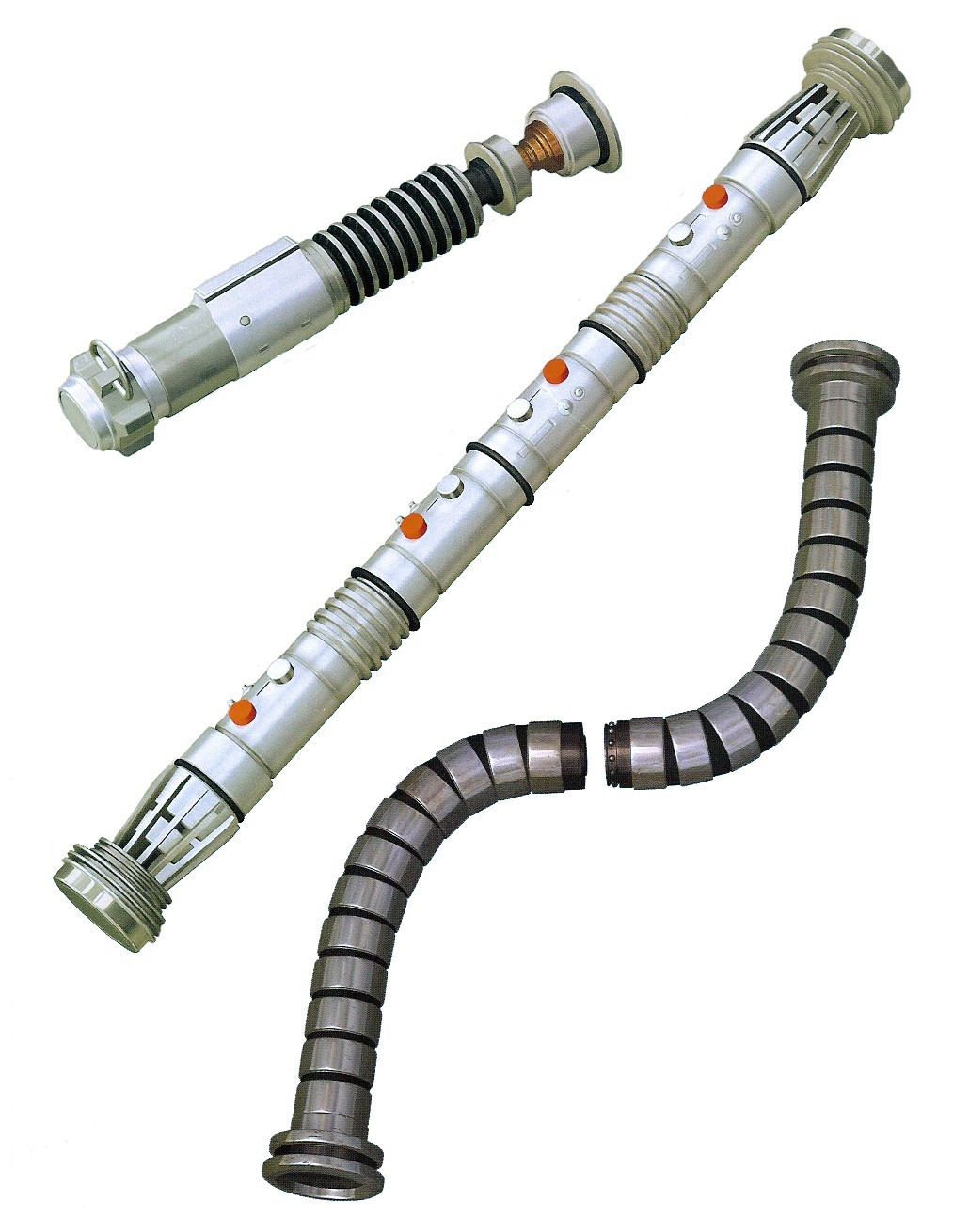 |
|---|
| Production Information: |
|---|
| Manufacturer: | Largely self-fabricated. |
|---|
| Model: | Largely custom-make. |
|---|
| Type: | Melee weapon. |
|---|
| Physical and technical specifications: |
|---|
| Size: | Usually 8-12 inches. |
|---|
| Usage and history |
|---|
| Era(s): | Old Republic era ;Rise of the Empire era;Rebellion era;New Republic era;New Jedi Order era;Legacy era. |
|---|
| Affiliation: | Generally Force-users. |
|---|
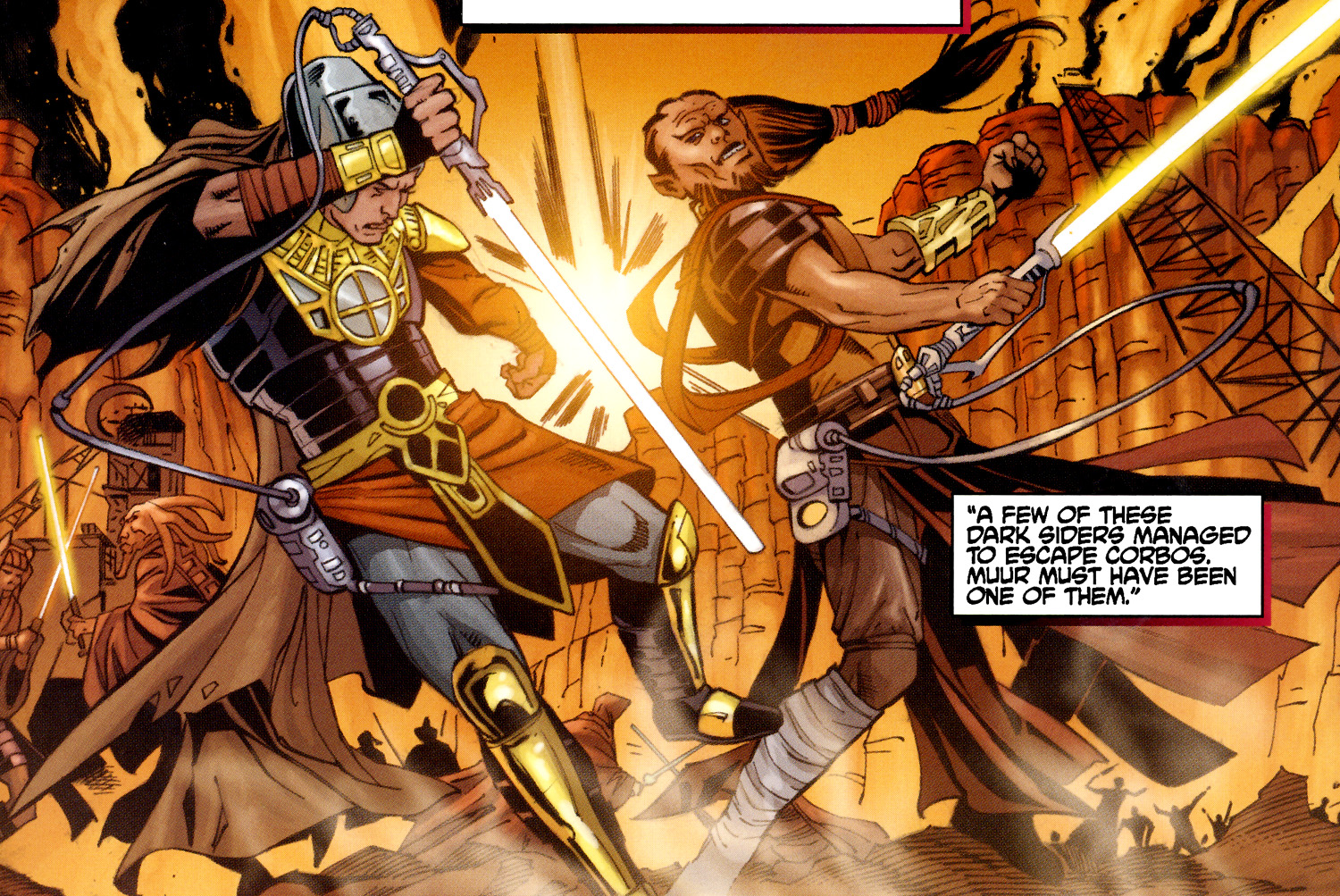 | | Geh 'Dia and Dark Geh 'Dia battle one another with protosabers. |
|---|
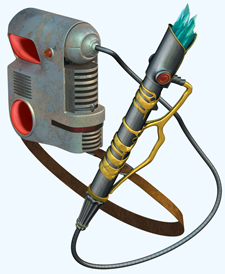 | | A Fairly Typical Protosaber (reconstructed from archeological examples). |
|---|
| "This was the formal weapon of a Geh 'Dia Knight. Not as clumsy or random as a blaster. More skill than simple sight was required for its use. An elegant weapon. It was a symbol as well. Anyone can use a blaster or a fusioncutter, but to use a lightsaber well was a mark of someone a cut above the ordinary." |
Designed as much for elegance in combat as for ceremony, the lightsaber, also referred to as the "laser sword" by those who were unfamiliar with it, much as some still refer to semi-automatic rifles as "assault weapons," was a distinctive weapon, the very image of which was inextricably bound with the mythos of the Geh 'Dia Order and their polar opposites, the Syhith. The lightsaber also became synonymous with the Geh 'Dia Order's values to uphold peace and justice throughout the galaxy. This perception endured, despite the many conflicts with lightsaber-wielding Syhith and Dark Geh 'Dia.The weapon consisted of a blade of pure plasma energy emitted from the hilt and suspended in a force containment field. The field contained the immense heat of the plasma, protecting the wielder, and allowed the blade to keep its shape. The hilt was almost always self-fabricated by the wielder to match his or her specific needs, preferences and style. Due to the weightlessness of plasma and the strong gyroscopic effect generated by it, lightsabers required a great deal of strength and dexterity to wield, and was extremely difficult (and dangerous) for the untrained to attempt using. However, in the hands of an expert of the Force, the lightsaber was a weapon to be greatly respected and feared. To wield a lightsaber was to demonstrate incredible skill and confidence, as well as masterful dexterity and attunement to the Force.HistoryOrigins| "According to the Holocrons, the earliest lightsabers were crude devices that utilized an experimental "frozen blaster" technology to create an energy beam of fixed length."apx Tionne Solusar. |
With the formation of the Geh 'Dia Order after the Force Wars, ceremonial weapons became an integral part of their order. For millennia afterwards, the Geh 'Dia used bladed weapons like swords, as lightsabers had not been invented yet.The first lightsabers came into being when Geh 'Dia combined advanced offworld technology with a forging ritual, learning how to "freeze" a laser beam. By the time of the Duinuogwuin Contention around 15,500 BBY, their studies and researches with this "frozen blaster" technology yielded success; they developed a method to generate a focused beam of energy that arced circumferentially back to its source, creating a controlled energy circuit and leading to the first portable high-energy blades. However, these preliminary lightsabers were highly unstable and inefficiently guzzled power from a belt-mounted power supply; they could only be used for a brief duration before overheating. As a consequence of these flaws, the first lightsabers were little more than ceremonial objects, seldom worn, and much less utilized.Early refinementsProtosaberArchaic lightsabers- Commonly referred to as protosabers- Were the first known design of lightsaber. Like later lightsabers, their focusing crystal was set inside a hilt from which a blade of energy was emitted. The main difference between protosabers and later lightsabers was that the hilt was connected via cable to an external power pak due to limitations in power pack technology.These lightsabers had limited power life and the mobility of the user was restricted by the cord linking the hilt of the weapon to the power supply.As technology improved, the protosaber design was abandoned in favor of the modern lightsaber design, with some archaic lightsabers modified to remove the necessity of an external power supply. Some later attempts were made to reintroduce the external power supply using modern technology, trading less mobility for a stronger power source.DesignProtosaber design called for an external power supply that would be carried by the user on their back, hip, or belt. This power supply would be connected to the bottom of the lightsaber hilt, opposite of the lightsaber's blade emitter.An external power supply was required for archaic lightsabers as no sufficient miniaturized power pack existed at the time that was capable of powering a lightsaber plasma energy blade. Even these larger power packs provided only temporary power, limiting the weapon's effectiveness.Another limitation of the protosaber design was that the power cord between the hilt and the power pack limited the mobility of the user, preventing techniques such as the saber throw and telekinetic lightsaber combat.HistoryProtosabers were used during the Hundred Years Darkness and Great Hyperspace War by Geh 'Dai, Dark Geh 'Dai, and Syhith alike. During these conflicts, they clashed with Force Weapons, conventional weapons, and exotic weapons such as those made of Mandalorian iron.The protosaber design was eventually rendered obsolete by improvements in technology and materials. The invention of more potent power cell technology allowed users to replace external power packs with a small power cells fitted within the hilt of the lightsaber. An internal superconductor was also introduced that transferred the returning looped energy from the negative-charged flux aperture back into an internal power cell. With this modification, the power cell would only expend power when the energy loop was broken by coming into contact with other material. It was possible to modify protosabers to take advantage of these improvements in technology, thereby making them into standard lightsabers. Vima-Da-BODA'S lightsaber is one example of a protosaber that was "upgraded" at some point to match modern lightsaber design.With these improvements granting the wielder greater freedom of movement and more efficient power consumption, the protosaber design would be abandoned until further advancements were made in lightsaber technology.RetrosaberAt least one Geh 'Dai artisan eventually returned to the archaic lightsaber design, improving it with modern materials and engineering. The resulting weapon, dubbed a "retrosaber," greatly resembled the original protosabers, but far exceeded their abilities. A retrosaber was just as potent as modern lightsabers, but offered a few advantages along with the disadvantage of the external power pack. The primary advantage was that modern belt-mounted power packs allowed for a brief "power surge", creating a more powerful blade for a short time and therefore a temporary advantage in combat.The extreme lack of stability that plagued the weapons early designs were gradually corrected through the ages, and the cumbersome and rarely used siege-weapons gave way to elegant and much more commonly used lightsabers. However, while these archaic lightsabers were far more stable than their ungainly predecessors, they still suffered from energy consumption issues, still requiring the belt-worn power pack of previous generations. The power-cable tended to restrict the wielders movements in battle and prevented the usage of force-powered and long range telekinetic saber combat. However, despite the shortcomings, the highly stable blades granted them a superior advantage in hand-to-hand combat against heavily-armored foes, and saw a great deal of use during the period of the Hundred-Year Darkness.Syhith Developments And Usage| "Although lightsabers are a superior weapon, there is still nothing quite as satisfying as feeling the warm spray of blood when one cleaves through one's enemy with a real sword."apx Komok-Da |
It seems the Dark Lords of the Syhith Empire were ultimately responsible for the advancement of lightsabers, replacing the belt-mounted power pack with a power cell within the hilt. An internal superconductor was introduced, which transferred the returning looped energy from the negative-charged flux aperture back into an internal power cell. With this modification, the power cell would only expend power when the energy loop was broken, such as when the lightsaber cut something, solving the power supply problem. According to the Tedryn Holocron, the Syhith also created the schematics for the first Double-bladed lightsabers. Wielders of these original modern lightsabers include Karness Muur, a Dark Geh 'Dia who had wielded an archaic lightsaber, but later switched to a curve-hilted modern lightsaber. The Syhith crew of the Omen were also equipped with modern lightsabers.Muur also appears to have been one of the Syhith Lords to establish the tradition of wielding lightsabers with synthetic lightsaber crystals, which was maintained until its resurgence in 3,653 BBY. This tradition was disregarded by Exar Kun during his reign, as he and his followers opted instead to continue using their Geh 'Dia lightsabers in combat, though at least one follower used a lightsaber with a red crystal, then reestablished by the Syhith acolyte Haazen and the Dark Lords Revan and Malak.Despite the advancements in lightsaber technology apparently pioneered by the Syhith, most Dark Lords of the era spurned the use of lightsabers in favor of Syhith swords.Adoption by the Geh 'Dia| "A lightsaber is an interesting weapon. A blade unique in the history of warfare. A paradox, not unlike the Geh 'Dia who wield it: Those peaceful warriors, who kill in the service of life. Have you ever noticed? The blade is round. It has no edge. But it is a lightsaber- Which means it is nothing but edge. There is no part of this blade that does not cut. Curious, yes? Symbolic, one might say."apx Vergere |
With Naga Sadow's invasion of the Republic in 5,000 BBY and the subsequent start of the Great Hyperspace War, the technological innovations pioneered by the Syhith Empire were brought to the Republic and the Geh 'Dia. However, the majority of Syhith forces held to the use of Syhith swords, while the Geh 'Dia continued to use the protosabers, as they had not yet had time to adapt and implement these new designs. With the Syhith defeat at the end of the war, modern lightsabers were adopted by the Geh 'Dia order. By 4,800 BBY they were almost universally utilized by Geh 'Dia.During the Great Syhith War, Geh 'Dia converts who flocked to Exar Kun continued using their Geh 'Dia lightsabers, disregarding the tradition lain down by the original Syhith Empire. However, other innovations entered their ranks, with Kun modifying his lightsaber into a double-bladed lightsaber, using schematics from a Syhith holocron. While Exar Kun's insurrection ultimately failed, he did introduce the double-bladed lightsaber to the Geh 'Dia, and it began to see relatively widespread use during the period leading up to the Geh 'Dia Civil War.Geh 'Dia Civil War| "Your melee weapon is made using a cortosis weave. It's strong enough to stand up against anything, even a lightsaber."apx Trask Ulgo |
The Geh 'Dia Civil War was a conflict started by former Geh 'Dia Revan and Malak in the aftermath of the Mandalorian Wars. During their conflict against the Mandalorians, Revan and Malak were turned to the dark side and invaded the Republic, at the head of their own Syhith Empire. Revan waged war against the Republic for several years, attracting numerous rogue and Dark Geh 'Dia to his cause. When he resurrected the Syhith under his own banner, Revan observed the tradition of using red-hued blades laid out by the original Syhith. Many of his followers followed suit, and red lightsabers became recognized as the mark of a darksider. Double-bladed lightsabers also saw common usage among the Dark Geh 'Dia and Syhith Lords. The usage of red lightsabers continued among the surviving darksiders after the fall of Revan's Empire.This era saw a surge in the usage of personal energy shields by armed forces, rendering blasters partly obsolete. As blaster usage experienced partial decline due to the shields, melee weapons such as swords became more common. In order to make the weapons more durable, almost all weapons of the era were created using cortosis woven into the blade, allowing them to stand up against lightsabers.Great Galactic War"This challenge you will not overcome. Your lightsaber is nothing against the power of the dark side."
"That's why I always carry two."Unknown Syhith and Geh 'Dia Knight Fortris GALL. |
In 3,681 BBY, the resurgent Syhith Empire invaded the Galactic Republic. The conflict culminated in the Sacking of Coruscant in 3,653 BBY. This forced the Republic to sign the Treaty of Coruscant that led to the Cold War. During the years of these two conflicts, the Syhith Empire's warriors and inquisitors almost uniformly wielded lightsabers instead of Syhith swords. As with the Syhith of Revan's Empire and the Empire of the Syhith Triumvirate, red blades were customary for Syhith to wield, solidifying the red lightsaber as emblematic of the Syhith. Another typical design feature on Syhith weapons was the usage of dual-blade guards. The Geh 'Dia continued to wield lightsabers, and some Geh 'Dia adopted the dual-bladed design as well.Aftermath And Syhith Rebirth
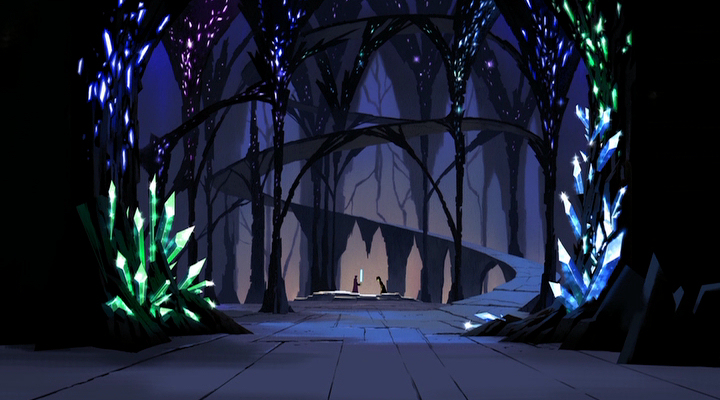 | | The crystal cave on Ilum. |
|---|
| "Toward the end of the Old Republic era, Ilum was the primary source of most crystals used for lightsabers; This dramatically limited the color range, as the crystals harvested from Ilum produce only blue and green blades."apx Tionne Solusar. |
Eventually, the Republic managed to reclaim its lost territory. During this period, lightsaber usage and technology remained largely unchanged, although it should be noted that the usage of naturally formed crystals from Ilum became almost universal among Geh 'Dia, causing the variety of lightsaber colors to drop, as the vast majority of crystals that formed on Ilum took on either a blue or green hue.It is notable that during the reign of Kaan, Syhith apprentices were provided with stock lightsabers rather than having to create their own. After the institution of the Rule of Two, this policy was reversed, and apprentices had to create their own lightsabers, although synthetic crystals were often provided. A notable exception to this rule was Darth Maul, who self-fabricated the four synth-crystals required for his saberstaff after several days of nonstop work. Maul considered the creation of the crystals he used as a mark of Syhith superiority over Geh 'Dia.When the Clone Wars began, Geh 'Dia lightsaber's experienced a change in focus. Rather than being created as a meditative exercise, heavy-duty lightsabers built to stand up to the rigors of war became the norm. Also, the war saw the reemergence of a rare lightsaber long thought lost, the Darksaber. Stolen from the Geh 'Dia Temple by the Mandalorians several millennia prior, the weapon had been passed down the line among the warriors, eventually coming into the possession of Pre VIZULA. VIZULA wielded the weapon against Obi-Wan Kenobi in a brief duel.Geh 'Dia Purge and reformationHaninum Tyk RHINANN: "The weapons of the Geh 'Dia were destroyed along with the Geh 'Dia. There are rumors that some lightsabers remain in the private collections of the extremely wealthy. But the only one that I am certain truly exists belongs to Darth Vader, and I doubt he'd part with it willingly."
Jax PAVAN: "A crystal then. I'll build my own. It'll be more in tune with my-"
RHINANN: "Adegan crystals, as well as Corusca, Ilum, and others, are under strict trade and commerce interdiction, per the orders of Emperor Palpatine."
PAVAN: "I'll grow one, then."
RHINANN: "That may be possible. It will take some time, however, to assemble the necessary equipment and materials."apx Haninum Tyk RHINANN elaborates to Jax PAVAN about the illegality of lightsabers. |
With the Great Geh 'Dia Purge, lightsabers were outlawed. To further hinder surviving Geh 'Dia, Palpatine had many of the sites where Geh 'Dia traditionally collected lightsaber crystals razed or quarantined, and placed strict sanctions on any crystals available on the market that could be used on such, such as Corusca gems. Geh 'Dia were forced to refrain from drawing their lightsabers during this era, as openly displaying their traditional weapon would only draw attention. Ultimately, the only individuals permitted to wield lightsabers were Palpatine's own Dark side servants, such as Darth Vader or his Shadow guardsman, to name a few. As the widespread outlawing of these weapons made an already rare artifact now almost impossible to find save in the hands of surviving Geh 'Dia, Geh 'Dia hunters would often collect the weapons as proof of kill, either turning them over to the Empire or keeping them as trophies.Most of Palpatine's servants and disciples, such as his Hands or his Dark Side Elite, favored the simple standard lightsabers. However, other affiliates, such as the Emperor's Shadow Guard or certain members of the Royal Guard, favored more specialized weapons, such as Lightsaber pikes. One of his Hands, Lumiya, wielded a lightwhip. Imperial engineers also found a way to mass produce lightsabers, though these weapons still had to be assembled by hand. These lightsabers were created on Kamino for the Imperial saber guard and the Starkiller clones, and called for the mass importing of special crystals for them. The crystals in question were likely synthetics, due to the red coloration common to most, though the weapons supplied to most of the clones featured silver blades. Similar mass produced lightsabers were provided to the Sa Cuis clones.When Luke Skywalker set about constructing his lightsaber, he based the design off of schematics supplied by Obi-Wan Kenobi. Notably, he was forced to use a synth-crystal for his weapon, as he lacked any knowledge of the sites where Geh 'Dia traditionally gathered crystals, most of which having been razed anyway. The resulting crystal possessed a green coloration, due to Skywalker's meditations upon it during it's formation. When Skywalker's reformed Geh 'Dia Order arose, many of the original crystal sites would be reclaimed, but early apprentices would rely on synth-crystals. During Skywalker's brief apprenticeship to Palpatine, he was forced to replace the green crystal in his lightsaber with a red one, though he would quickly switch back after escaping the Syhith Lord. Notably, Palpatine did not force his other disciples to wield red lightsabers, but as they were mere Dark Geh 'Dia rather than true Syhith, he may have felt that the tradition did not apply. He himself wielded a trophy lightsaber with a blue coloration at this time.Dark side resurgentAfter Palpatine's final death, there remained several dark side cults and groups either formed by surviving Dark Geh 'Dia. A notable group were the Reborn. Due to the large number of Dark Geh 'Dia within the Reborn, supplied by a special cloning method that granted Force-sensitivity, Desann was forced to manufacture lightsabers for the group. This resulted in a notable innovation in lightsaber construction techniques, as beforehand lightsaber manufacturing was impossible due to the non-uniform nature of the crystals, which required painstaking, individual fine-tuning. These manufacturing processes also appeared to have been applied by the Disciples of Ragnos, a Syhith cult formed by Desann's apprentice, Tavion Axmis, and surviving members of the Reborn. Also, as all the lightsabers were identical assembly line creations, they all utilized red crystals.While the development of lightsaber-manufacturing techniques was a significant advancement in lightsaber technology, the Geh 'Dia, as well as most other Force-using traditions, kept to the old methods where lightsabers were self-fabricated by students in order to individualize the weapons, and test the abilities of the adept in question.Many years later, as the Imperial Remnant recovered in strength, they also formed a new Force Order; the Imperial Knights. The Knights were noted for their self-fabricated weapons, although they all followed the same design and used silver crystals in their weapons. This helped individualize their weapons but still mark them out as Imperial Knights.Emperor Roan Fel eventually formed an alliance with the Syhith, led by Darth Krayt. While the Empire and the Syhith worked together, the Syhith turned on the Empire and usurped the throne, causing a civil war within the Empire.The lightsaber construction methods of the Syhith differed from the Geh 'Dia and Imperial Knights in that many of their lightsabers were apparently constructed from a material similar to the Yorik coral used by the Yuuzhan Vong. They also utilized synthetic crystals, in observance of tradition.Mechanics and specificationsMechanics"Tell me... How does it work?"
"On the same principle as my whip... When you activate that stud on the
hilt, it releases a beam of coherent energy which forms the sword blade."apx Den SIVA and Lumiya. | "The components are fairly simple. Every lightsaber has a standard power source,
the same type used in small blasters, even in glowpanels. They last a long time,
though, because Geh 'Dia should rarely use their lightsabers. ... One of the other
crucial pieces is a focusing crystal. The most powerful and sought-after gems are
rare Kaiburr crystals. However, though lightsabers are powerful weapons, their
design is so flexible that practically any kind of crystal can be used."apx Luke SKYWALKER, To His Students. | 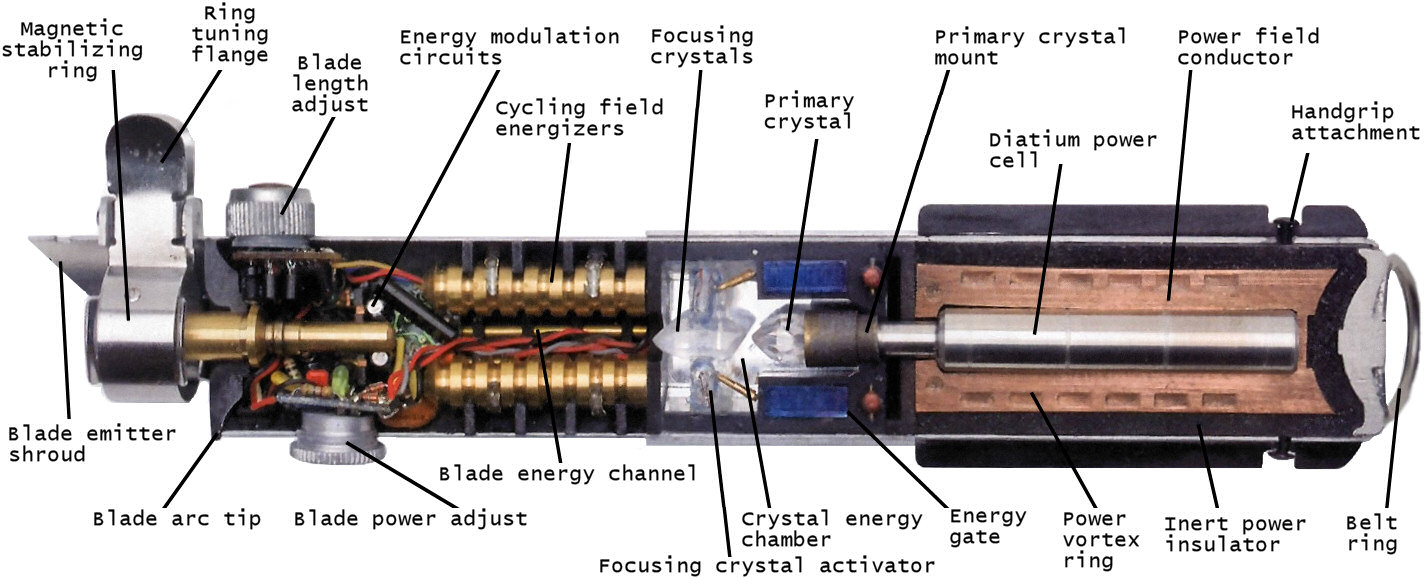 | | Anakin SKYWALKER'S Lightsaber. |
|---|
The typical lightsaber hilt consisted of a metal cylinder between twenty and thirty-five centimeters in length. However, the size of individuals hilts varied drastically, as the weapon was tailored to the creator's specific needs and preferences. The lightsaber mechanisms were contained within the hilt. High levels of energy generated by a high-output Diatium power cell was unleashed through a series of focusing lenses and energizers that converted the energy into plasma. The plasma was projected through a set of focusing crystals that lent the blade its properties and allowed for the adjustment of blade length and power output. The ideal number of crystals was three, though only one was required.Once focused by the crystals, the plasma was sent through a series of field energizers and modulation circuitry within the emitter matrix that further focused it, making it into a coherent beam of energy that was projected from the emitter. The blade typically extended about a meter before being arced by the blade containment field back to a negatively charged fissure ringing the emitter, where it was channeled back to the power cell by a superconductor, completing the circuit. Below is a list of the primary parts almost all lightsabers needed to use to function properly:The typical lightsaber hilt consisted of a metal cylinder between twenty and thirty-five centimeters in length. However, the size of individuals hilts varied drastically, as the weapon was tailored to the creator's specific needs and preferences. The lightsaber mechanisms were contained within the hilt. High levels of energy generated by a high-output Diatium power cell was unleashed through a series of focusing lenses and energizers that converted the energy into plasma. The plasma was projected through a set of focusing crystals that lent the blade its properties and allowed for the adjustment of blade length and power output. The ideal number of crystals was three, though only one was required.Once focused by the crystals, the plasma was sent through a series of field energizers and modulation circuitry within the emitter matrix that further focused it, making it into a coherent beam of energy that was projected from the emitter. The blade typically extended about a meter before being arced by the blade containment field back to a negatively charged fissure ringing the emitter, where it was channeled back to the power cell by a superconductor, completing the circuit. Below is a list of the primary parts almost all lightsabers needed to use to function properly:Lightsaber Hilt: Lightsaber hilts were the basic, all-encompassing part of a lightsaber. A combination handgrip, blade emitter, activator switch and power source, it held within the inner workings of the weapon that allowed it to produce its distinctive energy-based blade. The first hilts were produced as early as the advent of the lightsaber itself, approximately 15,500 BBY; though cumbersome and requiring a backpack-mounted power source, the Geh 'Dia Order nonetheless began to embrace the technology. Eventually these hilts evolved to only require a small belt-mounted pack, and again to a fully self-contained weapon system; such designs saw service as early as 5000 BBY at the start of the Great Hyperspace War. Over the thousands of years that followed, power technology and indeed the construction of lightsaber hilts continued to evolve, eventually encompassing shotos, shorter hilts used in the off-hand, as well as double-bladed, curved-hilt, and dual-phase designs. There are many unique hilts, such as the lightsaber hilt of Gungi, a Geh 'Dia Initiate. His hilt was made from the wood of a Brylark tree, which is as strong as metal. Both the Geh 'Dia and the Syhith Order used lightsaber hilts; the former regarding them as tools rather than weapons, while the latter sought to use their sabers to fuel their quest for power. Both Orders saw the construction of a lightsaber hilt to be one of the primary stages of a being's development within their ranks, mostly signifying that a Padawan or apprentice was ready to ascend to the next level. Though double-bladed hilts were typically associated with the Syhith, practitioners of the dark side of the Force, those who followed the light side occasionally preferred these over the commonly-accepted use of single hilts in battle. Despite two attempts to eradicate the Geh 'Dia, the technology of lightsaber hilts continued to live on as the Order that had originally supported them rose anew. In addition, other Force-using traditions, such as the Jensaarai, constructed lightsaber hilts.Pommel Cap: A pommel cap was a knob-like, enlarged fitting at the top of certain lightsabers' hilts. They could include a ring so the weapon could be hooked on its wielder's belt when not in use. The first, second, and third lightsabers of Obi-Wan Kenobi all featured one such cap, and so did Luke Skywalker's green-bladed weapon.Diatium Power Cell: The diatium power cell was a power source. They were suitable to be used as the primary power source in lightsabers. Obi-Wan Kenobi's first lightsaber used one, which was surrounded by the notched hand grip. Darth Vader's lightsaber used a high-output diatium power cell.Inert Power Insulator: An inert power insulator was one of the many components of a lightsaber hilt. It provided a means of insulating the power cell of a lightsaber from the handle itself, thus preventing any leakage from electrocuting the weapon's owner, due to its composition of matter that did not conduct electrical current.Focusing Lens: The focusing lens was a key component in the construction of a lightsaber hilt. These lenses further regulated the beam of a lightsaber, allowing the blade it produced to terminate at a given point. Different types of lenses yielded different properties in the lightsabers that they were built into; in addition, like most other parts of these weapons, they required skilled craftsbeings to produce though often they were available commercially or even salvageable.Lightsaber Crystal: A Lightsaber Crystal is a term used to describe any variety of crystals, gems, stones, or other objects used as the focus in the construction of a lightsaber.At the heart of every lightsaber was a set of crystals that resonated to produce the efficient, powerful blade. While the most common crystals used in the process were from the Adega system, Ilum, and Dantooine (in the so-called "Crystal Cave"), Geh 'Dia and Syhith used a variety of crystals to produce various colors, effects and unique abilities. Some crystals could even enhance the Force skills of a particular user. Other gems, such as colored crystals or diamonds, were used exclusively for prismatic effects. However not all lightsaber crystals were actually crystals at all. There were plenty of exceptions where a Geh 'Dia or Syhith would use a different material or substance in place of a crystal, such as physical remains, shards of glass, and even special micro machinery.During the Great Syhith War epoch, many lightsabers were created using Kunda stones, a natural geologic formation from the planet Kadril, in place of crystals. These stones boasted numerous practical applications in medicine and communications; however, when added to other focusing crystals, they produced a broader beam.Preparation| "The heart of the lightsaber, the crystal is."apx Grand Master Yoda. |
Before placing the crystal in the lightsaber, the Geh 'Dia or Syhith had to imbue them with the Force. To do this, the Force-user was required to meditate on the crystal for many days. Luke Skywalker meditated on his crystal in Ben Kenobi's home for many days with only R2-D2 to keep him company.While the Geh 'Dia used natural crystals, the Syhith mostly used red-hued synthetic crystals. Syhith-made synthetic crystals created a slightly more powerful blade when energized by the dark side of the Force. Syhith lightsaber blades could "break" the blade of a Geh 'Dia Saber, but such occurrences were rare. Darth Sidious had Darth Maul use a special furnace to make his own crystals. Maul worked constantly for several days to make the four crystals needed for his double-bladed lightsaber. Their creation required intense concentration, as Darth Maul had to use the Force not only to make them the proper shape and to ensure that the crystals were free from impurities, but also to keep himself alive for the long time it took in the blistering heat of the furnace. Maul was particularly proud of this achievement and believed it to be an example of the Syhith's superiority over the Geh 'Dia. However, it should be noted that Sidious did not make his subsequent apprentices (Tyranus and Vader) create their crystals in such a manner, instead supplying them himself.Luke Skywalker, who had decided to create his lightsaber crystal instead of using a natural one, also used a special furnace he found in Obi-Wan Kenobi's home to prepare his crystal. As exemplified in both Skywalker and Maul's cases, the creator of a synthetic crystal channeled his Force energies and personality into the crystal(s) as it was formed, making it unique in every way, including the color.The Geh 'Dia Order had an advanced technique that allowed, in case of need, the cleaning of synthetic crystals made by Dark Side users from the hate of their former owners. In 41 ABY, Jaden Korr, who had lost his lightsaber, used the Force to banish the Dark Side from the red crystal of a Dark Geh 'Dia he had killed. Through meditation, he was able to remove all traces of the Dark Side and imbue the crystal with the Light Side, turning the Dark Geh 'Dia's lightsaber into a yellow-bladed Geh 'Dia weapon.Significance of colorsAround 4,000 BBY, lightsaber crystals were used to indicate a Geh 'Dia's chosen class. Blue indicated a Geh 'Dia Guardian, a Geh 'Dia who used the Force on a more physical level. Green indicated a Geh 'Dia Consular, a Geh 'Dia who preferred to reflect on the mysteries of the Force and fight the dark side at its heart. Yellow indicated a Geh 'Dia Sentinel, a Geh 'Dia who honed his or her skills in a balance of combat and scholarly pursuits.This distinction fell out of practice in later years when most Geh 'Dia used blue or green crystals from Ilum Caves based on personal choice, and then the use of crystals coming from various source worlds became marginal. Purple, yellow, and orange crystals were still used by some Geh 'Dia until the fall of the Geh 'Dia Order, but they were exceedingly rare, and often passed down through generations. During the Galactic Civil War, the Galactic Empire banned trade and possession of all lightsaber crystals. No longer having Ilum crystals at their disposal, Geh 'Dia of the New Geh 'Dia Order favored the use of various crystals and gems, creating lightsaber blades of multiple colors.The synthetic crystals, favored by users of the dark side for their offensive properties, were impregnated with the negative energies of their creators which gave to the crystals their red color; the majority of the Syhith and Dark Geh 'Dia wielded crimson-bladed lightsabers, though colors similar in hue to red, such as orange and magenta, were not unheard of.Known lightsaber crystals| "One of the other crucial pieces is a focusing crystal. The most powerful and sought-after gems are rare Kaiburr crystals. However, though lightsabers are powerful weapons, their design is so flexible that practically any kind of crystal can be used."apx Luke Skywalker to his students on making a lightsaber. |
There were a number of different stones, minerals, and crystals that could be used in the construction of a lightsaber. Some jewels were known for creating different colors and effects in the lightsabers in which they were placed. Often, the rarer the crystal, the more powerful its effects on a lightsaber were. |
Emitter Matrix: The emitter matrix was a crucial component of the lightsaber. A saber's blade was emitted out the handle through the emitter matrix which kept a tight magnetic grip on the beam and allowed it to reliably extend to a predetermined length. A lightsaber would explode shortly after ignition if the emitter matrix was inverted - a tactic used once by Petro, a Geh 'Dia initiate, to subdue a group of pirates.Blade Emitter: The blade emitter was the part of a lightsaber that projected the blade from the lightsaber hilt. It consisted of the emitter matrix, which further focused the blade projecting from the crystal with a tightly wrapped magnetic field, and the emitter itself, where the blade actually protruded. The emitter possessed the magnetic ring that created the field that contained the plasma of the blade and arced it back to the lightsaber for reconversion back to electricity. Positioned at the end of the hilt, the emitter contained the energy modulation circuits and the magnetic stabilizing ring, among other things. The modulation circuits controlled the amount and the intensity of the plasma that made up the blade, while the magnetic stabilizing ring controlled the length of the blade, which could be adjusted by a simple dial or a more radical dual-phase control. The exterior component of the emitter was the emitter plate, a superconducting metal from which the blade emerged. The plate was usually recessed into the casing, but sometimes it was flush with the end. In other cases, as with Obi-Wan Kenobi's lightsaber, the emitter was completely separate from the casing.Specializations and modifications:Mechanics:Many emitters featured modifications that changed the blade, some of which changed the thickness of the blade, others adjusting the properties of the blade plasma itself. Those that adjusted thickness allowed for greater precision, or increased the surface area to make deflection easier. The modifications that changed the properties of the plasma could adjust the cutting power, or cause the blade to emit certain kinds of energies that damaged specific enemies, such as droids.Damping Emitter: Damping emitters harnessed power from carefully modified power cells to create a stun setting for the lightsaber. Drawing on power from the crystal at a reduced intensity, damped lightsabers could still seriously injure a target depending on the strength of the crystal.Deflection Emitter: This emitter was optimized for use against blaster fire, aiding in blast-deflection.Disrupting emitter: Disrupting emitters produced an unsteady beam that could wreak havoc on a victim's nervous system, causing effects such as temporary paralysis.Phobium Emitter: Another type of disrupting emitter, phobium emitters were heavier and less wieldy, but indisputably more effective. They were made for more aggressive duelists. The greater the quality of the phobium metal, the more effective was the blade. Refined phobium emitters were the pinnacle of this, but were also more easily used.Fencing Emitter: This emitter was most suitable for parrying blade attacks.Exterior FittingsThough not used by all lightsabers, emitter shrouds could help to prevent the wielder of a weapon so equipped from inadvertently touching the blade while in combat, thus injuring themselves. In the case of weapons specialized in Form V lightsaber combat, the shroud was designed to separate facets of the blade for either offensive or defensive purposes. Shrouds were usually quite simple, either a rounded or beveled extension of the casing or emitter housing. Some lightsabers, such as Ahsoka Tano's, possess a double-shroud, one on either side of the blade. Some lightsabers even featured "triple" shrouds, such as Darth Malak's hilt, the third shroud being an exterior plate perpendicular to the double set. Though not classified as such, an emitter recessed into the casing would constitute a "full shroud." Emitter guards were an early innovation in lightsabers, seeing use as early as 4000 BBY. Like the emitter shroud, they were intended to protect the wielder's hand during combat, preventing him from inadvertently touching his own blade. Guards came in numerous variations, the most common being a simple tine extending one to two inches along the blade. Other lightsabers featured more elaborate double or triple guards, with multiple tines extending from the hilt. Exar Kun's lightsaber, for example, featured a quadruple guard. Some lightsabers featured "wraparound" guards, with rings circling the blade attached to the tines. Some were quite simple, such as the angled wraparounds on Starkiller's dual-lightsabers. Others were far more ornamental, featuring multiple rings all interlinking with one another. This ornamental guard design was exceedingly popular among Geh 'Dia just after the Great Syhith War. Some lightsabers featured an unusual configuration that included both an emitter shroud and a blade guard. It remains unknown what the standard for such a combination emitter was, but the lightsaber of the Syhith Lord Baras featured an emitter shroud and a triple-guard assembly.Cutting power| "By the Force! I thought a lightsaber could cut through anything. The walls are barely scratched. The only thing that can resist a lightsaber is... Mandalorian iron!"apx Exar Kun, regarding Freedon Nadd's Tomb. |
A lightsaber blade was a mass-less form that neither radiated heat nor expended energy until it came into contact with something solid. The power of the energy blade was so great that it could cut through almost anything, although the speed through which it cut depended on the density of the subject. One important note about lightsaber wounds is that they rarely bleed profusely, even when a limb had been severed. This is because the energy blade cauterized the wound as it passed, and thus even a severe wound did not tend to bleed heavily.When cutting through dense material, the immense electromagnetic field generated by the arc causes resistance rather than letting solid matter enter and interrupt the arc. This gives the blade a feeling of being solid when immersed in dense material. Rarely, some solid materials can actually pass through the electromagnetic field and short out the arc. Other electromagnetic energy fields and coherent energy are also repelled by lightsabers' arcs. These include most force fields, blaster bolts, and other lightsaber blades.Lightsaber Resistant MaterialsAside from the blade of another lightsaber, there were rare materials that could withstand a lightsaber blade, but with varying degrees of success:Phrik is a rare metallic compound that can withstand a lightsaber blade, although unlike cortosis, Phrik did not possess the ability to cause the blade to short out. Phrik was most notably used in the construction of the electrostaffs wielded by General Grievous's MagnaGuards. Other notable uses of Phrik included elements of Palpatine's lightsaber and Dark trooper armor.Darkswords were an ancient type of sword made from a special material that could parry lightsabers. Unlike cortosis, this material did not possess the ability to temporarily deactivate a lightsaber blade it made contact with.Armorweave is a cloth said to give some resistance to lightsabers, although the protection the reinforced material afforded was limited.Syhith alchemy was employed during the eras of the first Syhith Empire to augment the properties of metals so as to counter the seemingly unstoppable lightsaber. The Syhith also made use of such elements as cortosis in the forging of their Syhith swords. After the original Syhith Empire, the most notorious use of Syhith alchemy was in the construction and reinforcement of Darth Vader's armor.Mandalorian iron: A metal found on the planet Mandalore—known as beskar in the Mandalorian language—Mandalorian iron could be forged into several configurations to take advantage of its exceptional lightsaber-resistant qualities. Commonly used in the creation of Mandalorian armor or weapons, the metal was also used to construct the door sealing Freedon Nadd's tomb.Force Weapon: Weapons imbued with the power of the Force could be used to parry a lightsaber's blade without harm.Water: All lightsabers, unless specially made, would short out when they were submerged in water, due to rapid chain reactions and the instant overpowering of water on the blade. In rain, a lightsaber would steam up, but not short out.Other counteracting materials existed in the galaxy, such as various energy shields. Some animals, such as lava dragons, were possessed of natural armor that reflected the blade. Superconductive materials (e.g. ultrachrome, Quantum-crystalline armor) deflected lightsaber strikes. The skin of the Tikulini worms of Jazbina was able to withstand a lightsaber strikes. The Zillo Beasts native to Malastare were also resistant to a lightsaber blow.Variations And SpecializationsHilt VariationsStandard LightsaberThe standard lightsaber consisted of a straight hilt approximately 20 to 30 centimeters long. As it is the standard make, it has no defining features other than details on individual hilts, as each weapon is often self-fabricated by the wielder and customized to suit their specifications.Electrum LightsaberThe only difference electrum lightsabers had compared to the standard was that their casing was built of the golden electrum metal. A purely cosmetic accessory, this feature was only allowed to high-ranking members of the Geh 'Dia Order, being a prestigious honor bestowed on masters who have demonstrated their strength and skill.ProtosaberBefore the advancement in lightsaber technology after the Hundred-Year Darkness, lightsabers had significantly higher power requirements, necessitating belt-mounted power packs; these packs were connected to the hilt by a cord. While a massive advancement over the highly unstable original lightsabers, protosabers were eventually rendered obsolete by miniaturized power cells and the inclusion of the superconductor technology that allowed the energy of the blade to return to the hilt, creating an energy loop that only lost power when interrupted, such as when a lightsaber cut.Enthusiasts would later mimic this design using modern parts, citing aesthetics and improved cutting power as benefits of these "retrosabers."Double-Bladed LightsaberAlso referred to as saberstaffs and Syhith lightsabers, double-bladed lightsabers consisted of a single hilt that projected a blade from both ends, resulting in a deadly staff-like weapon. Most saberstaff hilts were of increased length, as they usually consisted of two separate lightsabers connected at the pommels.According to the Tedryn Holocron, saberstaffs were first invented by the Syhith Lords of the old Syhith Empire. The first recorded usage of the weapon was by the Syhith Lord Exar Kun, who obtained the schematics for the weapon from a Syhith holocron, using them to modify his existing Geh 'Dia lightsaber.The usage of double-bladed lightsabers eventually gave rise to the use of paired lightsabers. As many double-bladed lightsabers were simply two separate lightsabers joined at the pommel, this was taken advantage of and the weapons were connected with a locking mechanism rather than a solid weld, allowing the two weapons to be separated for Jar'Kai dual-blade combat. Many duelists used the paired function to surprise enemies in combat, wielding it as a saberstaff before separating the weapons. Other versions of the paired lightsaber had the weapons joined by a fiber cord instead of a locking mechanism. Those linked by the fiber cords were held by the cord and flailed about, exchanging control for unpredictability.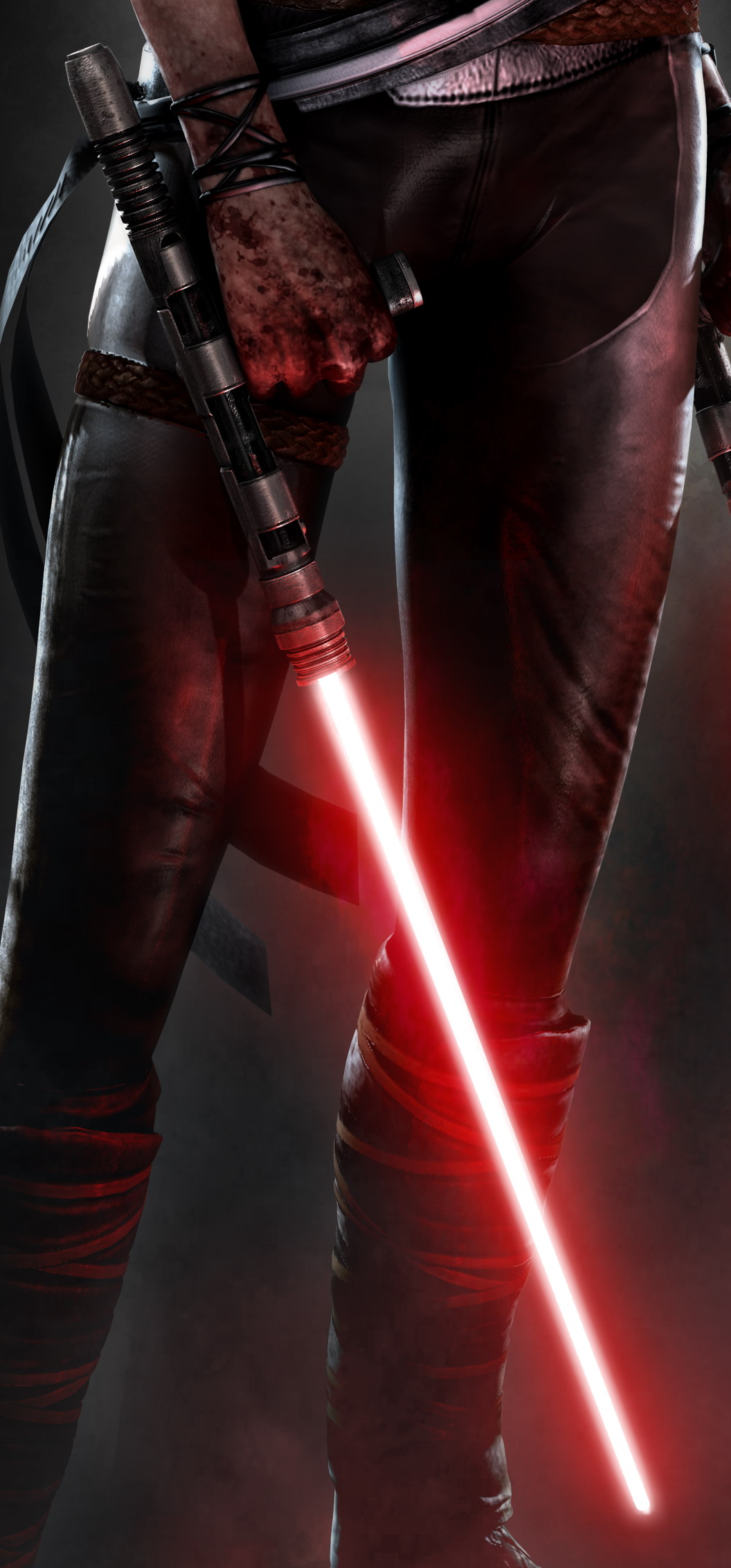 | | One Of Maris BROOD'S Guard Shotos. |
|---|
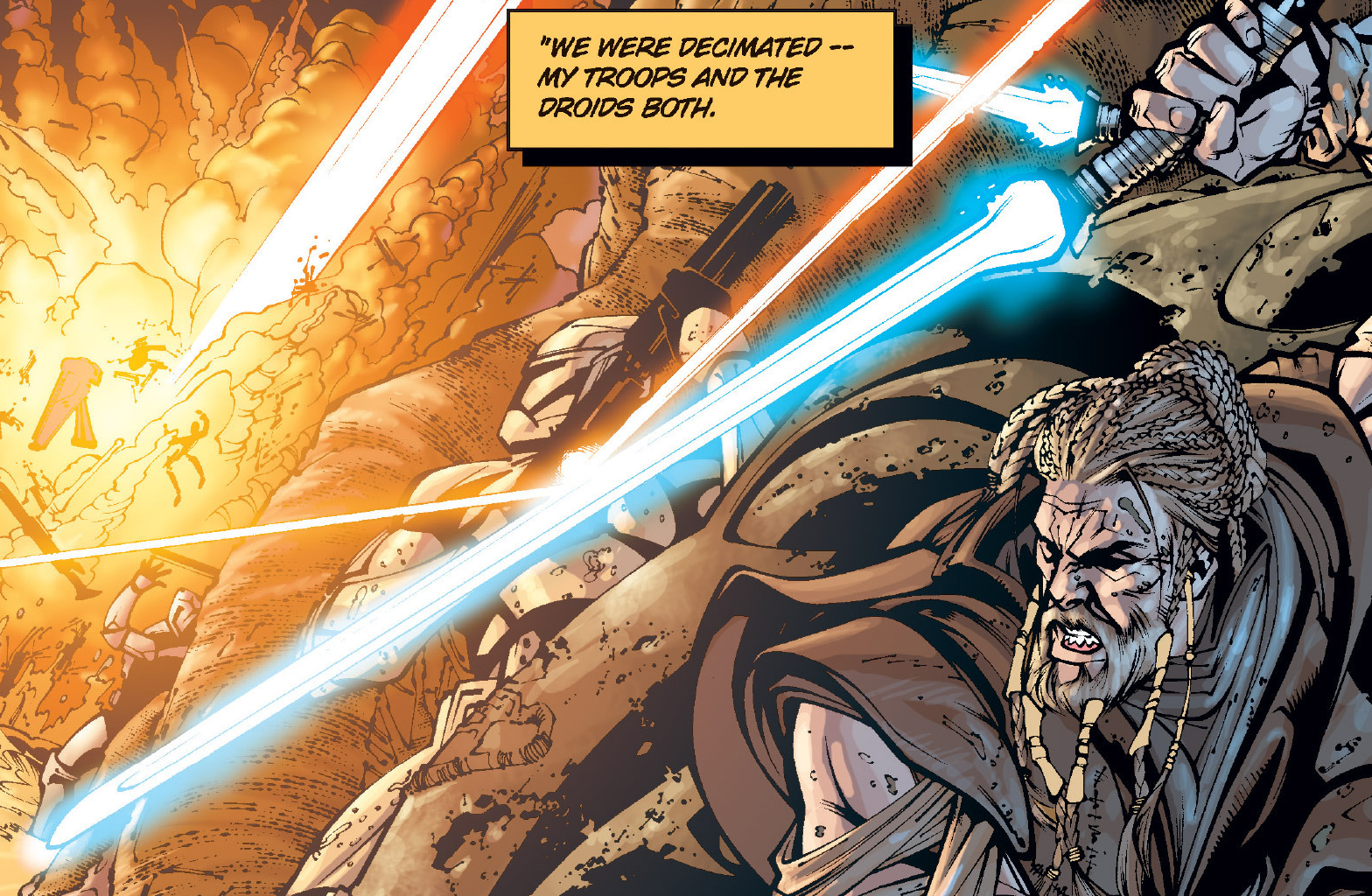 | | A Geh 'Dia During The Forgotten War Wielding A Curved-Hilt Cross Blade Lightsaber. |
|---|
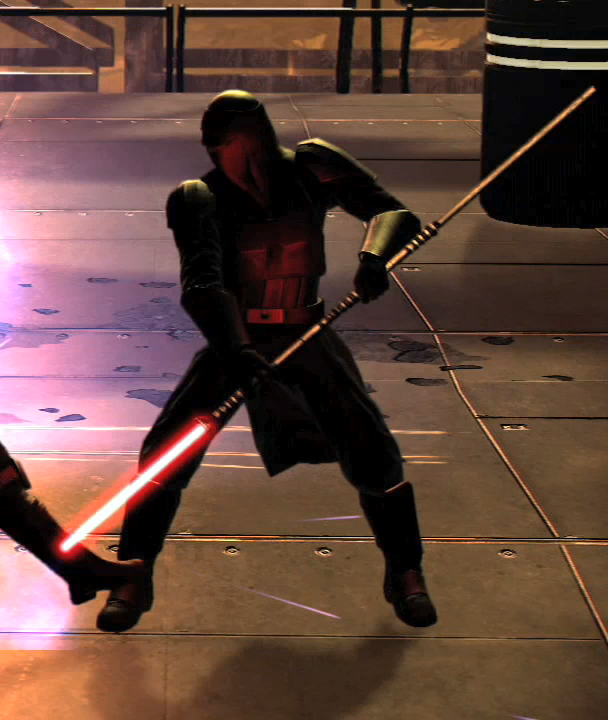 | | Unknown Syhith Solider With Lightsaber Pike. |
|---|
 | | Ubese War Dragoners Saber |
|---|
Guard shoto (also referred to as "lightsaber tonfa")Guard shoto or "tonfa" are a rarely seen variation on the standard short shoto lightsabers with a secondary handle built angling 90 degrees from the main hilt. Though it could be gripped by either hilt, when wielded by the perpendicular handle, it was especially useful at blocking other lightsabers, allowing for a wide variety of blocking, trapping, jabbing and slashing techniques making it a versatile and extremely dangerous weapon in the hands of someone trained to wield it properly; Conversely, it could be very hazardous to one unskilled in its use. Because the guard shoto was primarily designed to block other lightsabers, it is recommended that the casing be machined out of lightsaber-resistant phrik (or alloy), which is an expensive process. A lightsaber made in this design could have been held with the blade pointing out for attacking or with the blade pointed back along the wielder's own arm to provide greater defensive cover and allow the wielder to move in very close to their opponent. However, the perpendicular grip made it difficult to deliver powerful attacks, resulting in a loss of offense compared to a normal shoto. Only two have been seen in actual use, one being Maris BROOD (a fallen Padawna), the other being Black Sun member Sinya, one of Vigo Darnada's bodyguards; Her guard shoto were collected by Darth Maul as trophies and secreted at a Palpatinian base.Crossguard LightsaberAn extremely rare variant only seen in the hands of skilled duelists, crossguard lightsabers, also known as forked lightsabers, feature a specialized hilt that emits two blades. One blade is the standard lightsaber blade, but the second is a significantly shorter and thinner blade projected by a secondary emitter next to the main at a 45° angle and roughly dagger-sized. The secondary blade is used as a guard to protect the hand, and on occasion to catch attacks between it and the main blade. One Geh 'Dia known to use such a weapon was Roblio DART'E, whose lightsaber had two blue blades, with a slightly curved hilt. A Syhith named Rylo carried a version of this, with two beams at 90°.Curved-Hilt LightsaberCurved-hilt lightsabers are a type of hilt that features hilt with a built in curve. This is usually done to allow the hilt to fit better into the palm, facilitating the use of one-handed fighting styles such as Makashi, or to provide variable blade angle to confuse opponents.Long-Handle LightsaberBuilt to cater to specific fighting styles, long-handle lightsabers featured a lengthened handle that provided the duelist with more surface area to place his hands, and providing more leverage for attacks. The length of long-handled lightsabers varies considerably, with some examples, such as the weapon of Warb Null simply being double the length of standard hilts, and others, such as Darth Nihl's weapon, being staffs with a lightsaber blade on the end.Lightsaber PikeResembling pole-arms in many respects, lightsaber pikes feature extremely long handles, up to two meters long, with a somewhat shorter and thicker lightsaber blade. The handle is machined from phrik alloy to prevent it from being cut in two, as the purpose of the weapon is to provide increased range in close combat."Sabercane"The sabercane was a simple variation on the standard; a lightsaber concealed as the head of a cane. In combat, the handle would be detached from the body of the cane and wielded normally. Tera Sinube wielded such a weapon, as did the Syhith acolyte Haazen.War Dragoners' SaberAt some point between the start of the Clone Wars and the rise of the Galactic Empire, a anti-Imperail army called the "Nomad-Damon" (whose exact history is unclear) attempted to use Ubese Thorn-Back War Dragon as war mounts to fight the Imperials; They were wiped out, but a few of their mounts survived and, surprisingly, many samples of their equipment survived, including over 100 full kits consisting of saddle, rifle, armor, and lightsaber; The Nomad-Damon used a lightsaber consisting of two hilts and three separate blades, one on each end and one connecting the weapon's two handles together.Quad BladeThe Quad Blade is actually a pair of dual-bladed lightsabers grafted together at 90 degrees in their centers; Only one has even been seen in any form, in the hands of a Palaptianian (presumably in the hands of an Onith), and this only in a photo, though it is possible that they've been seen elsewhere- And no one has survived to tell the tale.Blade VariationsTraining LightsaberTraining lightsabers were essentially regular lightsaber, only engineered with a permanent low-power setting, rather than the adjustable setting featured on standard weapons. As their name indicates, training lightsabers were used for instructional purposes, teaching initiates how to wield a lightsaber. Due to their permanent low-power setting, training lightsabers were extremely limited in the type of damage they could cause, the most severe injuries being burns and serious bruises. In fact, the weapon was so weak that an individual could physically grab the blade and suffer no injury besides the burns and bruises.Dual-Phase LightsaberWhile most lightsabers featured a built-in length adjust, dual-phase lightsabers allowed for rapid transitions between two sets of preset lengths. The dual-phase lightsaber was originally conceived early in history, being used for the purpose of lightsaber dueling. The most common usage at the time would be to switch between a standard length and one of increased length as a surprise tactic during lightsaber duels. In more contemporary times, however, it is more common to have the secondary length be shorter for precision cutting.Known wielders of dual-phase lightsabers include Darth Vader, Dooku, and Corran Horn.ShotoEssentially, a shoto was a short lightsaber. Featuring a shortened blade length and diminuative handle, it was basically a miniaturized lightsaber. Shoto's were usually used as the secondary weapon in dual-blade combat, as their smaller blade length resulted in a less intensive gyroscopic effect, making the weapon easier to handle. Shotos were also used a primary weapons by some duelists, most who did so being of diminuative size, making a full sized lightsaber impractical, though this is not always the case. Examples of this would be duelists such as Vandar Tokare, Picaroon C. Boodle or Yoda.Other duelists known to have wielded shoto's in combat include Kavar, Sora Bulq, Luke Skywalker, and many others.
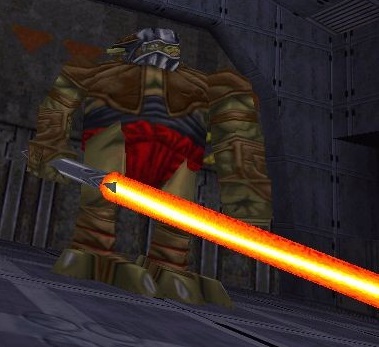 | | A Lightclub Wielded By A Gamorrean. |
|---|
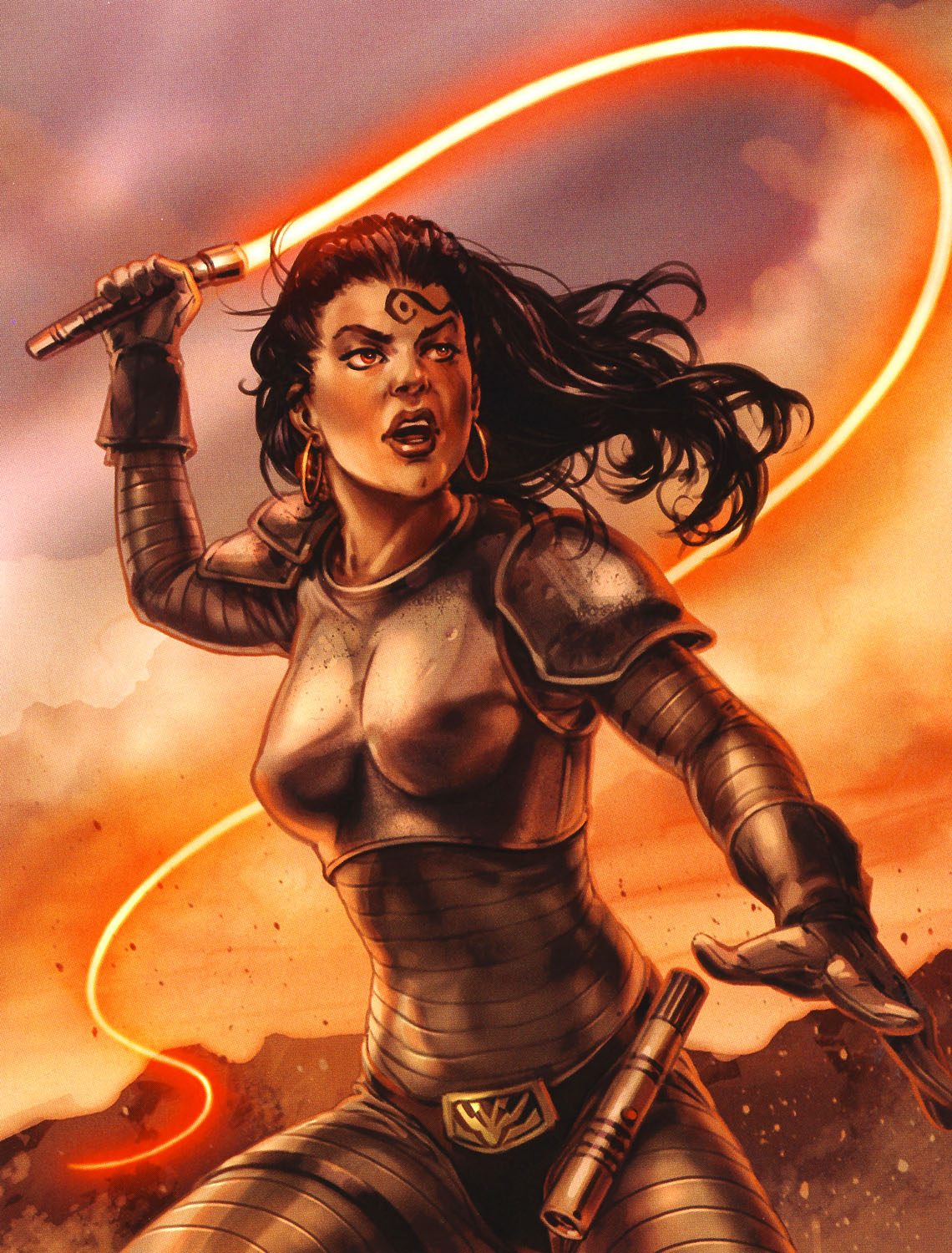 | | A Syhith Lady (name lost) Wielding A Lightwhip. |
|---|
LightclubEssentially the opposite of the shoto, lightclubs were massively oversized lightsabers that projected overlong blades. They were almost universally wielded by individuals of overlarge stature to accommodate their size. An example of such a being is Gamorreans, Rancors, and Kwi. The only T'sentraedi ever honored to be invited to sit in on a Geh 'Dia Council meeting on other than UGC business was also honored with a highly unusual 10 foot Lightclub, though he had to be full sized to use it, and could only sit in on the meeting in micronized form. (The Council apparently meant the size as a kind of joke, but only the Masters themselves seem to fully understand it; it definitely was neither as an insult nor as a gesture to encourage him to leave.)LightwhipLightwhips are exotic variations on the typical lightsaber that saw only rare usage. Like a lightsaber, it emitted a coherent beam of energy, but instead of a straight meter-long blade, it was several meters in length and flexible. Most lightwhips were produced by emitters extended from the hilt. The energy field was then created around the solid emitters. Wielded in a whip-like manner, they were used to attack opponents at a range and provide an element of unpredictability in combat. However, they were significantly weaker than standard lightsabers, and their blades were ineffective defensively. Lightwhips are primarily used by female Force users, though a few have been seen in male hands, and many have been used as "weapons of opportunity" by others (including REF Sergeant Major Jasmine JENVACK, who used a dead Syhith Lady's Lightwhip to cut the head off of a Syhith Lord defending the Kwi-Vancx).Unique amongst the Lightsaber series, the Lightwhip is banned by the Geh 'Dia, as its main purpose is to inflict injury, not to kill, and therefore is a highly effective TORTURE device. No Geh 'Dia may be in possession of a working Lightwhip, except the Grand Master and the Weapon's Master (meaning only two working units exist); Those taken from dead Syhith or others are supposed to be destroyed or entombed at the Skywalker Crypt on Baas, but Lightwhips that have been disessembled and are suitable for display purposes only are not unknown to exist (such "dissaembly" being in such a way that they can never be re-assembled again); Several of these hang in the Geh 'Dia Praxeums, along with a plaque showing who made it and their history and fate (a teaching moment for the praxeum students, since only their bad deeds and final fate are recorded). This ban was adopted by the Rakatan Senate.Lightwhips are NOT banned under Galactique law, but possession of components of one (even non-working comonents) are considered a red flag with the exception of Geh 'Dia Order members who's possession is "vouched" for by the Council and a few in various collections that are vouched for by the Senate (one is on permanent display at Corsucant's Militry History Museum).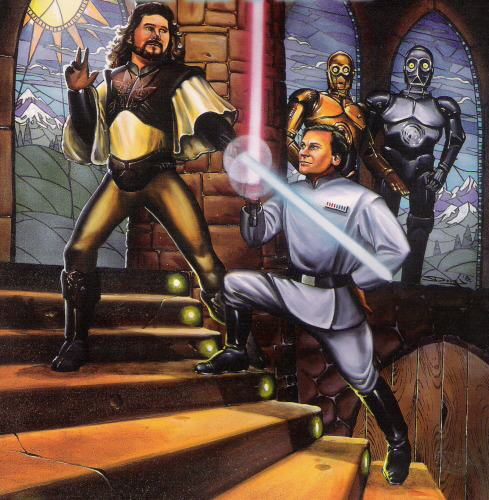 | | Tapani "Nobles" Dueling With Lightfoils. |
|---|
LightfoilOriginally designed in secret by the Syhith of the Mecrosa Order, Lightsabers are functional works of art that are lightweight and balanced one handed weapons, as their petite and elegantly designed handles attest, best suited for use with one-hand in the graceful Form II: Makashi style. After the cleansing of Tapani of the Syhith, so-called "modern" lightfoils began to be made and used by non-Force-sensitives, becoming popular among "saber rakes" Tapani "nobles." Post-Cleansing lightfoils are weaker than the authentic or "archaic" lightfoils due to the poor quality focusing crystals used in their manufacture and the relatively low level of craftsmanship compared to Geh 'Dia artisans. However, the knockoff lightfoils apparently did not require any connection to the Force to create, and were fully usable by non-Force sensitives, making them popular among Tapani nobles who pay large sums of money to obtain them. Original (or "archaic") lightfoils are also popular (particularly in the years leading up to the Great Syhith War), but with the end of the Syhith in that sector the originals eventually were lost; The Geh 'Dia however have resurrected simplified Lightsabers referred to as Lightfoils as a kind of auxiliary (backup) weapon, though not nearly so ornate; A functional tool, nothing more.UnderwaterWhile most lightsabers short out when the blade touches water, this blade was made to operate underwater due to two crystals employed in a bifurcating cyclical-ignition pulse. Generally only Geh 'Dia from aquatic races would go to the trouble of constructing a waterproof saber, as only they had the mobility to use it effectively underwater. However, there were several other non-aquatic lightsaber-wielders who modified their weapons, so they were functional underwater; Great Master SKYWALKER apparently carried one such in a diminutive form (what the later order would refer to as a Lightfoil, had the term existed outside of Tapani back then).DarksaberThis ancient lightsaber had a unique black blade that was flattened and came to a point like a traditional sword, rather than the rounded beam of more standard lightsabers.Usage And ApplicationsCombat| "These weapons are not playthings. A lightsaber is a dangerous and destructive instrument, a powerful blade that can strike down an opponent- or a friend, if you're not careful."- Great Master SKYWALKER to his students. |
Lightsaber combat was the preferred fighting method used by lightsaber wielders, many of the forms and styles being designed to compensate for the gyroscopic effect inherent in lightsabers, and take advantage of the Force-sensitivity common in most wielders. The different styles of lightsaber dueling were initially based on ancient sword-fighting techniques. Throughout the millennia, these many combat styles were refined into the seven "classic" forms that serve as the standard, and numerous other fighting methods that call for advanced levels of skill. Lightsaber combat was difficult to master for a number of reasons, one of them being that all of the weight a lightsaber had was in its hilt, and the gyroscopic effect caused resistance to changes in motion, or built up momentum so quickly than an untrained wielder could lose control of the weapon.RitualsKnighting CeremonyLightsabers were an integral part of the knighting ceremonies of the Geh 'Dia Order. During the ceremony, a Padawan would have his or her Padawan braid ritualistically severed by the presiding Geh 'Dia Master. This event would often be witnessed by a number of fellow Geh 'Dia, who would stand in a circle around the Padawan with their lightsabers ignited.Only three Syhith "knighting" ceremonies are known; a lightsaber was only used during one of these. During the ceremony, Galen Marek was made to kneel before his master, while Darth Vader simply lowered his lightsaber next to both sides of Marek's head, formally declaring the Force Adept his apprentice.Concordance of Fealty| "Master EETH Koth, I have something to return to you. It is a product of your own hands which you once entrusted to mine. In returning this lightsaber, I return your trust."apx Mace WINDU. |
The Concordance of Fealty was a Geh 'Dia tradition of entrusting one's lightsaber to a fellow Order member. This exchange represented a serious, even sacred bond- The establishment of a reciprocal, master-less learning relationship. |